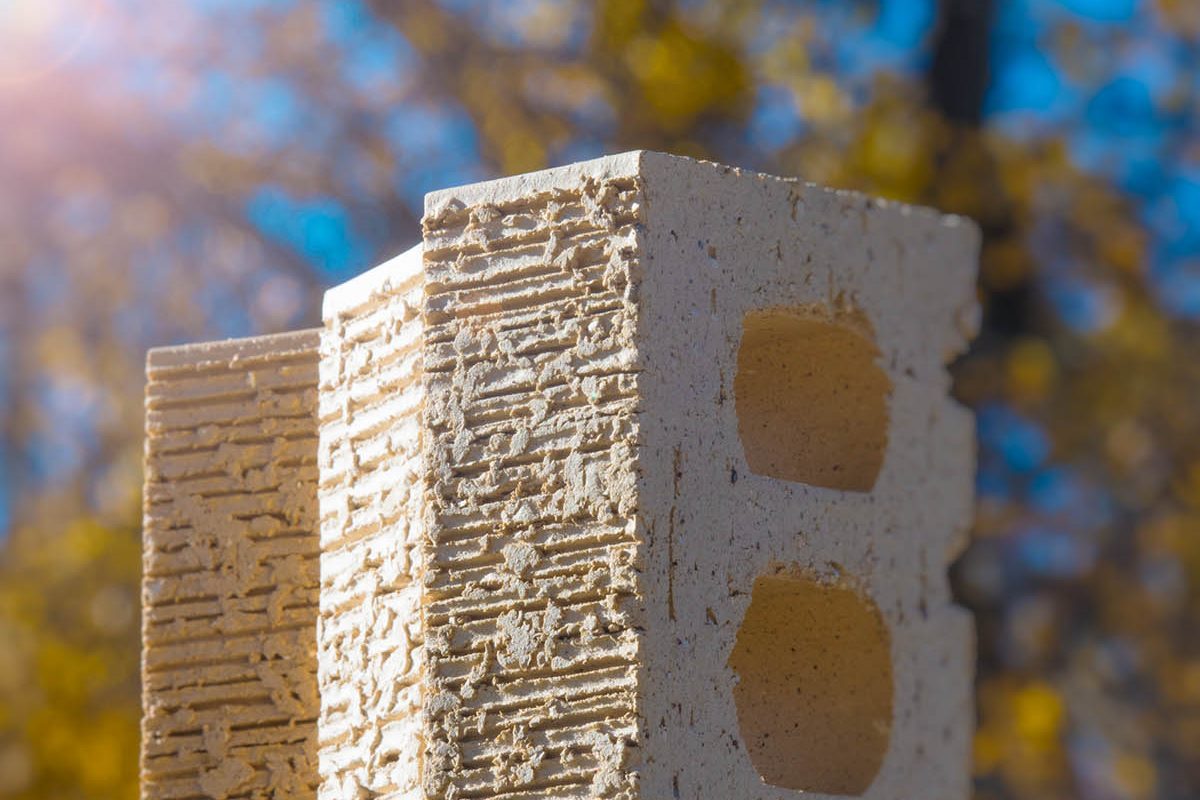
Courtesy of Acme Brick Co. | Photo by Louis Curtis
The Story Behind an Iconic Brick Color
One of TCU’s signature styles is steeped in history, business and branding.
An essential aesthetic of the TCU campus, the buff brick that encases each building has a story that plays a vital role in the university’s visual identity.
When fire destroyed the main building on the Waco campus in 1910, TCU considered four suitor cities before choosing Fort Worth. Gene Smith, professor of history in the AddRan College of Liberal Arts, said the four original Fort Worth campus buildings were “constructed out of reinforced concrete and brick … because it didn’t burn.”
Smith theorized that the buff brick first came from an industrial center in Thurber, Texas, roughly 70 miles west of Fort Worth, that supplied materials for many other local buildings in that era. “It was probably the cheapest of the brick that they could secure.”
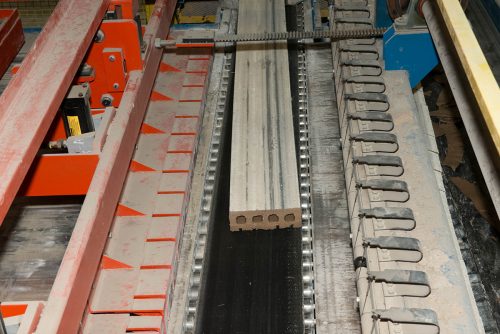
At an Acme Brick plant, one long column of clay (called a slug) is positioned before being pushed through a cutter that makes individual bricks. Courtesy of Acme Brick Co. | Photo by Spencer Martinez
Today, the university uses Acme Brick Company. Dennis Knautz ’75 (MBA ’76), president and CEO, said his company is proud to provide the official brick of TCU.
Acme owns several plants in the United States, from Colorado to Alabama. The buff brick comes from Perla, Arkansas. Clay from a massive pit burns white and buff, a fact that originally attracted Acme to the site. A new TCU building can require 200,000 bricks, Knautz explained, but the supply won’t run short any time soon, as Acme has 30 to 50 years of raw material available.
Todd Waldvogel, associate vice chancellor for facilities and campus planning, said the fluctuation in brick color — the tans, creams and beiges — harkens to the early days of construction when a kiln changed the brick’s color, adding warmth and depth.

A setting machine stacks bricks not yet fired in the kiln (called green brick). A combination of specific clay and kiln temperature create the iconic TCU buff brick color. Courtesy of Acme Brick Co. | Photo by Spencer Martinez
Since then, the brickmaking process and kiln technology have evolved, but TCU still relies on intentional changes in hue to keep a universal feel among buildings. The current recipe involves drilling, mixing, drying and heating, a process that changes the chemical composition of the clay, something Knautz likened to turning sand into glass.
Smith attributed the university’s embrace of the buff brick as part of its overall aesthetic to the construction patterns on the young campus. “[Construction] came in what I would call fits and starts.”
The first stint was 1910 to 1911, when most of the buildings on University Drive were built. The library went up in the early 1920s, followed by a third construction period for residence halls.
“By the time that most of the construction, the significant construction, was happening … they decided that they wanted to have everything look the same,” Smith said. And thus the brick standard was born.
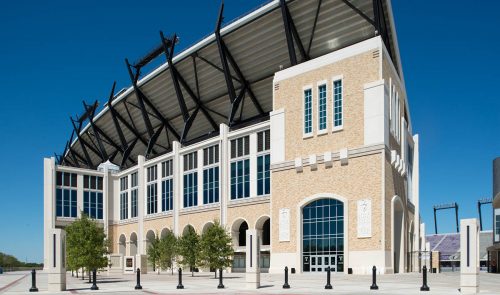
The facade of Amon G. Carter Stadium, one of the most frequently visited buildings on campus, is enveloped in TCU’s signature brick. Courtesy of Acme Brick Co. | Photo by Britt Stokes
All but a few buildings match the original core, and the three colors of brick currently used on campus “are adjusted to match the original,” Waldvogel said. When constructing buildings, he said, his team at the physical plant uses different mixes of brick to give each building or area a singular feel.
For example, Waldvogel said the new Greek Village uses the standard bricks with a uniquely proportioned mixture of the same colors to give it a “residential feel,” but each chapter house has a different mix.
The brick and color express a “sense of place” at TCU, Waldvogel said. The former U.S. Air Force civil engineer approves the building mock-ups created by his design team, and even the grout is a deliberate decision, he added.
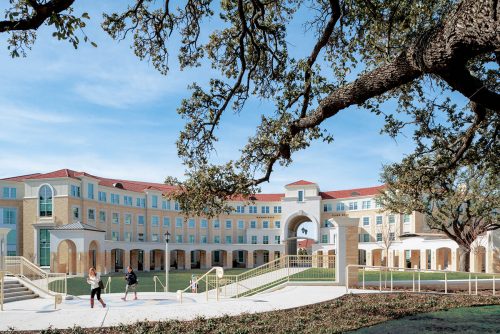
TCU’s signature brick and roof color were used for new residence halls in Worth Hills, like Marion Hall and Pamela and Edward Clark Hall. Courtesy of Acme Brick Co. | Photo by Louis Curtis
During construction spurts in the 1940s, TCU gained another signature style: the red roof.
Food, raw materials and other resources were rationed during World War II to aid the war effort. It became impossible for the university to construct dorm roofs with traditional asphalt-based shingles, which contained a petroleum byproduct, Smith explained. Instead builders used an inexpensive clay tile. When the university started replacing roofs, Smith said, officials decided to implement clay tile as a visual staple.
The buff brick also plays a key role in the university’s brand standards. The color is featured on TCU’s “executive” and “natural” secondary color palettes. These secondary palettes, used since 2013, give the university “latitude and creativity,” said Liz Parks-Gunsell, assistant director of the Office of Graphic Design. The brick color can appear in promotional material, TCU publications and any other university product.
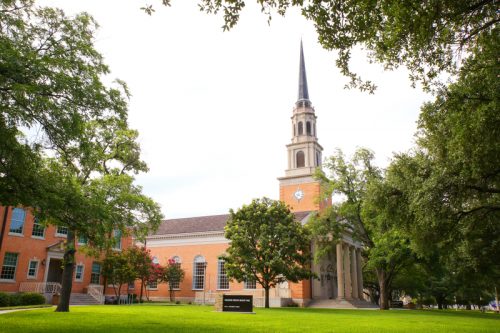
The exterior of Robert Carr Chapel has rose-colored bricks — a deviation from the typical TCU buff brick. Photo by Amy Peterson
Among the architectural anomalies on campus, Robert Carr Chapel and its rose-colored brick stand out the most. The chapel was built in 1953 after then-President M.E. Sadler’s wife fell in love with a chapel of the same design on a trip to New England, Smith said. But it wasn’t immediately welcomed on campus. “There were actually protests because it was the wrong color brick.”
Waldvogel cited the Moudy buildings as another brick outlier on campus, something he chalked up to design practices in the 1980s.
Today, Waldvogel and his team are focused on “modern adaptations of traditional styles” and giving TCU a “village feel,” rather than a commuter one, he said. And even though anomalies and imperfections exist, he and TCU care more about getting the big impressions right.
With a view of Amon G. Carter Stadium from his office, Knautz said he enjoys staying in regular contact with TCU. Although his company serves other colleges in the state, such as Texas Tech and Baylor, “people in Acme Brick know TCU is one of our faves.”

Your comments are welcome
2 Comments
I appreciate the rose colored brick of the chapel and its related buildings centering on undergraduate religion and Brite Divinity School. I see them as a Salute to our Christian heritage. I do see the Moudy building as an outlier and hope that one day they will add buff colored brick to its exterior. Improvements have been made to the Walsh Performing Arts Center. I wonder, though, if the rust colored rear of this building has or will be changed. It is reminiscent of Texas’ color brand and distracts from the common area between Waits and Foster. In addition, the GrandMarc’s Berry Street facade needs to be purple or buff rather than green, an unwelcome reminder of Baylor! Finally, it will be interesting to see the long range plans realized for the area around the new administration building. I trust it will reflect the sense of place and beauty found in the buildings and grounds on University Drive. Overall, it has been a joy to see the campus evolve. I will always love TCU!
My grandfather was the manager of a brick plant in Malvern Arkansas in the 1940s and 1950s. I am not sure what plant it was – it may have been the ACME Perla plant, but at that time Malvern had 4 brick plants and was the brick making capital of North America! But it is an interesting connection.
Related reading:
Alumni
Dennis Knautz ’75 (MBA ’76), CEO of Acme Brick
Getting out from behind the desk enabled Knautz to shape the company that helped build Fort Worth.
Mem’ries Sweet
It’s a boy. It’s a dog. It’s SuperFrog!
Over the course of a century, the TCU mascot has varied in design and species.
Mem’ries Sweet
KTCU Host Interviewed Celebrities like Bob Hope, Don Knotts
Barto Farrar brought bandleaders, country stars and even a Nobel-winning scientist to the KTCU airwaves.